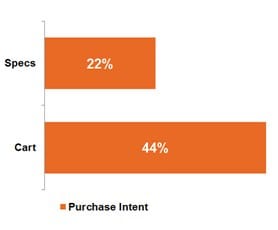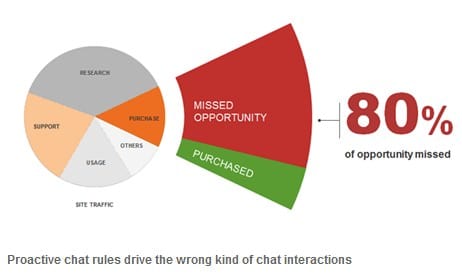Fight the Big Data Backlash and use Smart Data help you identify purchase intent
Big data is starting to experience some significant backlash. A ‘case in point’ comes from a recent popular article in VentureBeat: ‘Big data’ is dead. What’s next? The backlash is more to do with the buzz than the data but the reason relates to the difficulty of extracting meaningful insights from big data.
Born from the backlash comes another buzzword; smart data, a means of extracting these meaningful insights from big data.
Looking past the marketing hype, smart data is actually the metamorphosis of big data into something actionable. Here we look at recognizing purchase intent as an example of actionable data extraction.
Big data vs Smart data rundown
So let’s start with the basic question of what is big data? Big data refers to massive volumes of structured and unstructured data collected and stored from a range of sources such as social media feeds, web traffic, sales data and other emerging forms of unstructured data feeds like video. Typically, this data set is too large to be analyzed using traditional statistical analysis and can be overwhelming when trying to extract actionable information. Smart data on the other hand is big data with context, where that context is aligned to business needs and objectives. The advantage of smart data is that the barriers of big data analysis are removed and its meaning is not subject to a wide range of interpretations, in other words it is a strong signal. An example of strong signal data is survey data from website visitors who answer a set of focused questions. These questions are specifically designed to reveal important needs-based information such as visitor intent. These data sets are clear, user-led and easy to leverage, providing a straightforward approach to data interpretation and assisting big data sets to become actionable smart data. While quantitative and descriptive data offer valuable insights for marketers, qualitative data offers opportunities for improved customer engagement and understanding.
Big data, strong signals, Smart Insights
There have been a number of advancements in the big data field in terms of collection, storage and clustering. BUT according to IDC, while 22% of digital information was a candidate for analysis, only 5% was actually analyzed! As noted in a recent Fortune article, a lot of data still sits in fragmented systems that don’t “talk” to one another, which renders the information almost useless. 
The big opportunity for big data is how to extract a ‘strong signal’ from the noise. Collecting big data and mining it mercilessly is not the opportunity. The opportunity is leveraging ‘a strong signal’ data set and integrating it to label big data, thus making it immediately usable. This is where an information rich contextual data set can inform big data and turn it into smart data.
Let’s take a real example: Say you were trying to identify and target website visitors who intend to purchase. If you were to rely only on mining your web analytics data for this information you would have to sort through the entire data set looking for the behavioral traits of purchase intenders. This not only is difficult but could be wildly inaccurate. You would think that focusing on the shopping cart is all you would have to do to get a stronger signal of purchase intent, but there is more to the story. Data shows that for a typical e-commerce site only 44% of visitors that enter the cart actually have the intent to purchase while the remaining 56% represent all other intent types such as researchers.
By labeling your data set with a ‘strong signal’ such as visitors who are actually intending to purchase, you can segment and contextualize the web data illuminating the most important aspects of the data set.
Empowering your Big Data
Collecting visitor stated intent, or in other words the way someone describes their intention for visiting a website, provides a much stronger signal because it is the visitor who describes their intention. 
iPerceptions research shows that a visitor who states that they intend to ‘purchase’ is 15 to 20 times more likely to do so than someone who describes their intent to ‘research’. This powerful qualitative intent data paired with quantitative and descriptive data creates contextualized data sets, transforming your big data into smart data.
By proactively identifying a visitor with the intent to purchase but who is in distress also, a company can intervene in the current session to aid this user with their purchase. Tactical intervention can not only increase sales but improve loyalty towards the brand and mitigate further follow-up through alternative channels like a call to customer service. Labelling your big data with a ‘strong signal’ and turning it into smart data is great but it is still just data. To go beyond ‘just data’ and allow it to have an impact on your customer experience and your bottom line you need to take action on it. Here we’ve given only one example of an action that can come from your smart data that is specific to electronic commerce, but the potential for actionable advice is huge if you can contextualize your quantitative and descriptive datasets through the voice of your customer.
Putting it all together - Big and Smart Data
Big data is complex and vast but many of the benefits cannot be truly realized without adding contextual information. If these data sources are combined not only can you transform big data into smart data, but you can also provide enormous windfalls for consumers and companies alike improving the customer experience and the company’s ability to meet the needs of its customers. However having the right type of data is only half the story. To make personalization a reality and directly impact the customer experience, a real-time approach to leveraging this information must be taken so that the quickly eroding opportunities can be recognized and acted upon.

Thanks to Duff Anderson for sharing his thoughts and opinions in this blog post. A visionary in digital voice of customer research, Duff has been providing expert advice on how to gain a competitive advantage across the digital customer for over 15 years. Duff is a founding member of iPerceptions and is a featured speaker and contributor on the subjects of digital analytics, marketing technologies and customer experience management. iPerceptions is a leading digital customer research company that enriches marketing technologies with the Voice of the Customer. Recently,
iPerceptions launched Active Recognition™ a game changing technology that recognizes the intent of anonymous website visitors in real-time to provide personalized experiences. You can connect via
LinkedIn or
Twitter.





 Thanks to Duff Anderson for sharing his thoughts and opinions in this blog post. A visionary in digital voice of customer research, Duff has been providing expert advice on how to gain a competitive advantage across the digital customer for over 15 years. Duff is a founding member of iPerceptions and is a featured speaker and contributor on the subjects of digital analytics, marketing technologies and customer experience management. iPerceptions is a leading digital customer research company that enriches marketing technologies with the Voice of the Customer. Recently,
Thanks to Duff Anderson for sharing his thoughts and opinions in this blog post. A visionary in digital voice of customer research, Duff has been providing expert advice on how to gain a competitive advantage across the digital customer for over 15 years. Duff is a founding member of iPerceptions and is a featured speaker and contributor on the subjects of digital analytics, marketing technologies and customer experience management. iPerceptions is a leading digital customer research company that enriches marketing technologies with the Voice of the Customer. Recently, 


